An Adaptive Filtering Approach Based on the Dynamic Variance Model for Reducing MEMS Gyroscope Random Error
Abstract
1. Introduction
2. Angular Rate Related Dynamic Variance Model
2.1. Equipment Installation
2.2. Data Acquisition
2.3. Variance Calculation
2.4. Dynamic Variance Model
3. Adaptive Filtering Method Based on Online Measuring Noise Coefficient Adjustment
3.1. Non-Stationary Random Signal Modeling Methods
3.2. Kalman Filter Design with ARIMA Model-Based State Equation
3.3. Measuring Noise Coefficient Online Adjustment-Based Adaptive Filtering Approach
4. Experiments and Results
4.1. Experimental Equipment
4.2. Experimental Procedure
4.3. Verification Experiments
4.3.1. Kalman Filtering State Equation Utilizing the Time Sequence Model
4.3.2. Kalman Filter Design
4.3.3. Different Angular Rate Experiment Verification
- (1)
- Constant Rotation Rate Filtering Experiments
- (2)
- Continuous-Changing Angular Rate Filtering Experiments
- (3)
- Long Term Constant Rotation Rate Filtering Experiments
5. Conclusions
Author Contributions
Funding
Conflicts of Interest
References
- Zhang, Y.; Liu, W.; Yang, X.; Xing, S. Hidden Markov Model-Based Pedestrian Navigation System Using MEMS Inertial Sensors. Meas. Sci. Rev. 2015, 15, 35–43. [Google Scholar] [CrossRef]
- Li, X.; Li, Z. Vector-Aided In-Field Calibration Method for Low-End MEMS Gyros in Attitude and Heading Reference Systems. IEEE Trans. Instrum. Meas. 2014, 63, 2675–2681. [Google Scholar] [CrossRef]
- Narasimhappa, M.; Sabat, S.L.; Nayak, J. Adaptive sampling strong tracking scaled unscented Kalman filter for denoising the fibre optic gyroscope drift signal. Meas. Technol. 2014, 9, 241–249. [Google Scholar] [CrossRef]
- Huang, Y.; Vasan, A.S.S.; Doraiswami, R.; Osterman, M.; Pecht, M. MEMS Reliability Review. IEEE Trans. Device Mater. Reliab. 2012, 12, 482–493. [Google Scholar] [CrossRef]
- Zhang, Y.; Li, Y.; Peng, C.; Mou, D.; Li, M.; Wang, W. The Height-Adaptive Parameterized Step Length Measurement Method and Experiment Based on Motion Parameters. Sensors 2018, 18, 1039. [Google Scholar] [CrossRef] [PubMed]
- Kim, Y.W.; Yoo, H.H. Design of a vibrating MEMS gyroscope considering design variable uncertainties. J. Mech. Sci. Technol. 2010, 24, 2175–2180. [Google Scholar] [CrossRef]
- Tatar, E.; Alper, S.E.; Akin, T. Quadrature-Error Compensation and Corresponding Effects on the Performance of Fully Decoupled MEMS Gyroscopes. J. Micro Electro Mech. Syst. 2012, 21, 656–667. [Google Scholar] [CrossRef]
- Leland, R.P. Mechanical-thermal noise in MEMS gyroscopes. IEEE Sens. J. 2005, 5, 493–500. [Google Scholar] [CrossRef]
- He, C.H.; Liu, D.C.; Zhao, Q.C.; En, Y.F.; Yang, Z.C.; Zhang, D.C.; Yan, G.Z. A novel narrow-band force rebalance control method for the sense mode of MEMS vibratory gyroscopes. Measurement 2015, 62, 197–204. [Google Scholar] [CrossRef]
- Kundra, L.; Ekler, P. Bias Compensation of Gyroscopes in Mobiles with Optical Flow. Aasri Procedia 2014, 9, 152–157. [Google Scholar] [CrossRef]
- Dichev, D.; Koev, H.; Bakalova, T.; Louda, P. A Kalman Filter-Based Algorithm for Measuring the Parameters of Moving Objects. Meas. Sci. Rev. 2015, 15, 19–26. [Google Scholar] [CrossRef]
- Salah, M.H.; McIntyre, M.L.; Dawson, D.M.; Wagner, J.R.; Tatlicioglu, E. Sensing of the time-varying angular rate for MEMS Z-axis gyroscopes. Mechatronics 2010, 20, 720–727. [Google Scholar] [CrossRef]
- Jafari, M.; Najafabadi, T.A.; Moshiri, B.; Tabatabaei, S.S.; Sahebjameyan, M. PEM Stochastic Modeling for MEMS Inertial Sensors in Conventional and Redundant IMUs. IEEE Sens. J. 2014, 14, 2019–2027. [Google Scholar] [CrossRef]
- Georgy, J.; Noureldin, A.; Korenberg, M.J.; Bayoumi, M.M. Modeling the Stochastic Drift of a MEMS-Based Gyroscope in Gyro/Odometer/GPS Integrated Navigation. IEEE Trans. Intell. Transp. Syst. 2007, 11, 856–872. [Google Scholar] [CrossRef]
- Jiang, H.; Yang, W.-Q. State Space Modeling of Random Drift Rate in High-Precision Gyro. IEEE Trans. Aerosp. Electron. Syst. 1996, 32, 1138–1143. [Google Scholar] [CrossRef]
- Yan, Y.; Guo, P.; Liu, L. A Novel Hybridization of Artificial Neural Networks and ARIMA Models for Forecasting Resource Consumption in an IIS Web Server. In Proceedings of the IEEE International Symposium on Software Reliability Engineering Workshops, Naples, Italy, 3–6 November 2014; pp. 437–442. [Google Scholar]
- Li, C.; Chiang, T.-W. Complex Neurofuzzy ARIMA Forecasting—A New Approach Using Complex Fuzzy Sets. IEEE Trans. Fuzzy Syst. 2013, 21, 567–584. [Google Scholar] [CrossRef]
- Yuan, G.; Zili, D. Self-Tuning Measurement Fusion Kalman Filter For Multisensor Systems with Companion Form. In Proceedings of the 2010 8th IEEE International Conference on Control and Automation (ICCA), Xiamen, China, 9–11 June 2010; pp. 854–859. [Google Scholar]
- Qi, Z.; Li, Q.; Yi, G.; Fang, H. A Hybrid Forecasting Approach for HRG Parameters Based on Output Time Series. In Proceedings of the 26th Chinese Control and Decision Conference (2014 CCDC), Changsha, China, 31 May–2 June 2014; pp. 2606–2610. [Google Scholar]
- Zhang, C.; Wang, L.; Gao, S.; Li, H.; Lin, T.; Li, X.; Wang, T. Dynamic Allan variance analysis for stochastic errors of fiber optic gyroscope. Infrared Laser Eng. 2014, 43, 3081–3088. [Google Scholar]
- Sungsu, P.; Roberto, H.; Chin-Woo, T. Dynamics and control of a MEMS angle measuring gyroscope. Sens. Actuators 2008, 144, 56–63. [Google Scholar]
- Yoon, S.W.; Lee, S.; Najafi, K. Vibration-induced errors in MEMS tuning fork gyroscopes. Sens. Actuators 2012, 180, 32–44. [Google Scholar] [CrossRef]
- Guo, W.; Long, X. Research on Stochastic Errors of Dithered Ring Laser Gyroscope Based on Dynamic Allan Variance. Chin. J. Lasers 2010, 37, 2975–2979. [Google Scholar] [CrossRef]
- Shen, Q.; Liu, J.; Wang, J.; Zhao, H. Dynamic Identification of MEMS Gyros Random Error Terms. Piezoelectr. Acoustoopt. 2014, 36, 945–948. [Google Scholar]
- Lv, Y.; Xiao, Q.; Yang, L. Random error modeling and compensation for MEMS gyroscope. Electron. Meas. Technol. 2012, 35, 41–45. [Google Scholar]
- Ham, S.; Kim, S.; Lee, N.; Kim, P.; Eom, I.; Lee, B.; Tsai, P.J.; Lee, K.; Yoon, C. Comparison of data analysis procedures for real-time nanoparticle sampling data using classical regression and ARIMA models. J. Appl. Stat. 2016, 44, 685–699. [Google Scholar] [CrossRef]
- D’Jakonov, E.G. Difference schemes with splitting operator for higher-dimensional non-stationary problems. SSSR Comput. Math. Math. Phys. 1962, 2, 549–568. [Google Scholar]
- Yang, P.; Li, Q. Kalman Filtering of MEMS Gyro Based on Time-series Model. In Proceedings of the 9th International Conference on Electronic Measurement & Instruments, Beijing, China, 16–19 August 2009. [Google Scholar]
- Yan, G.; Li, S.; Qin, Y. Inertial Instrument Testing and Data Analysis; National Defense Industry Press: Beijing, China, 2012; pp. 143–148. [Google Scholar]
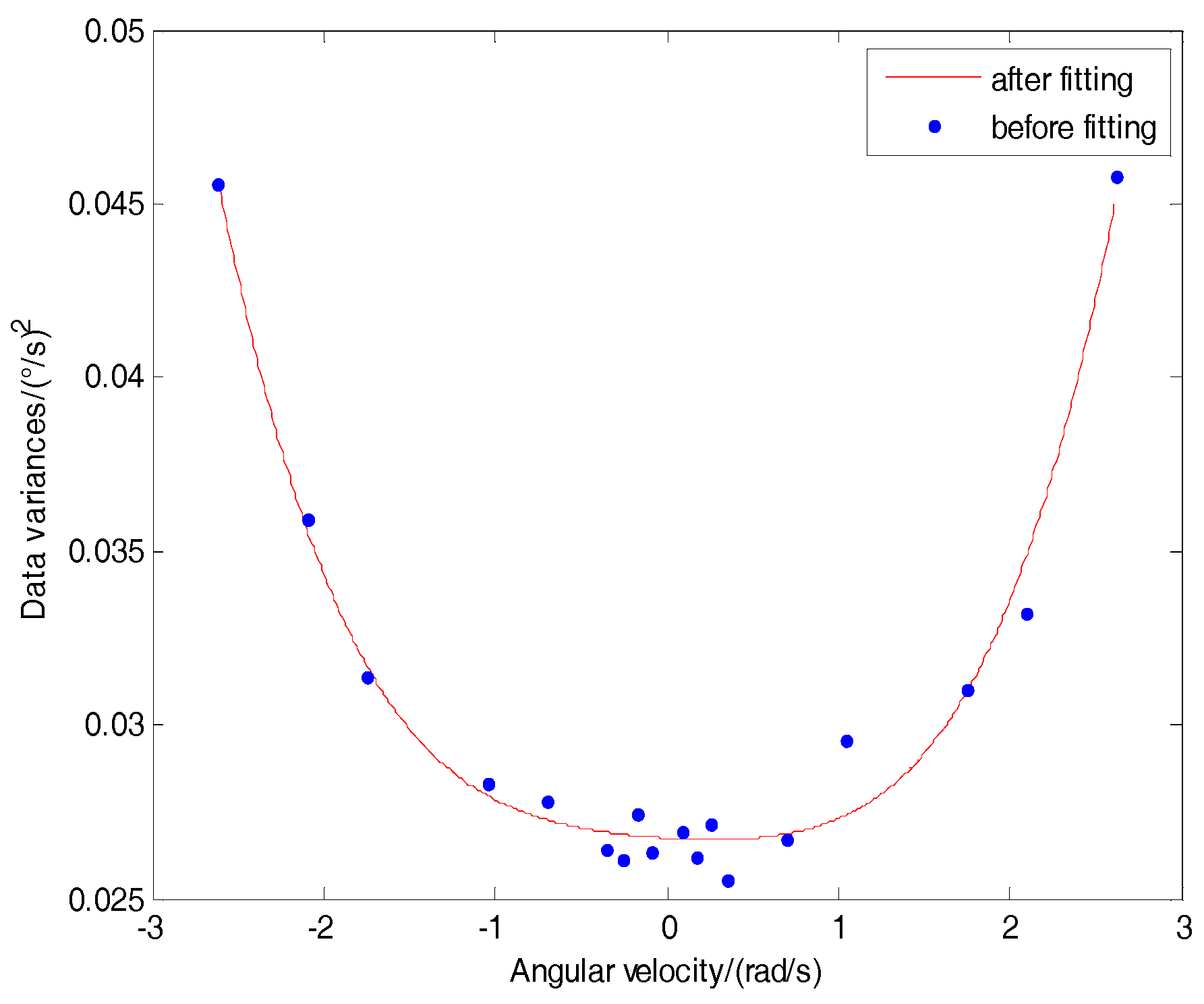
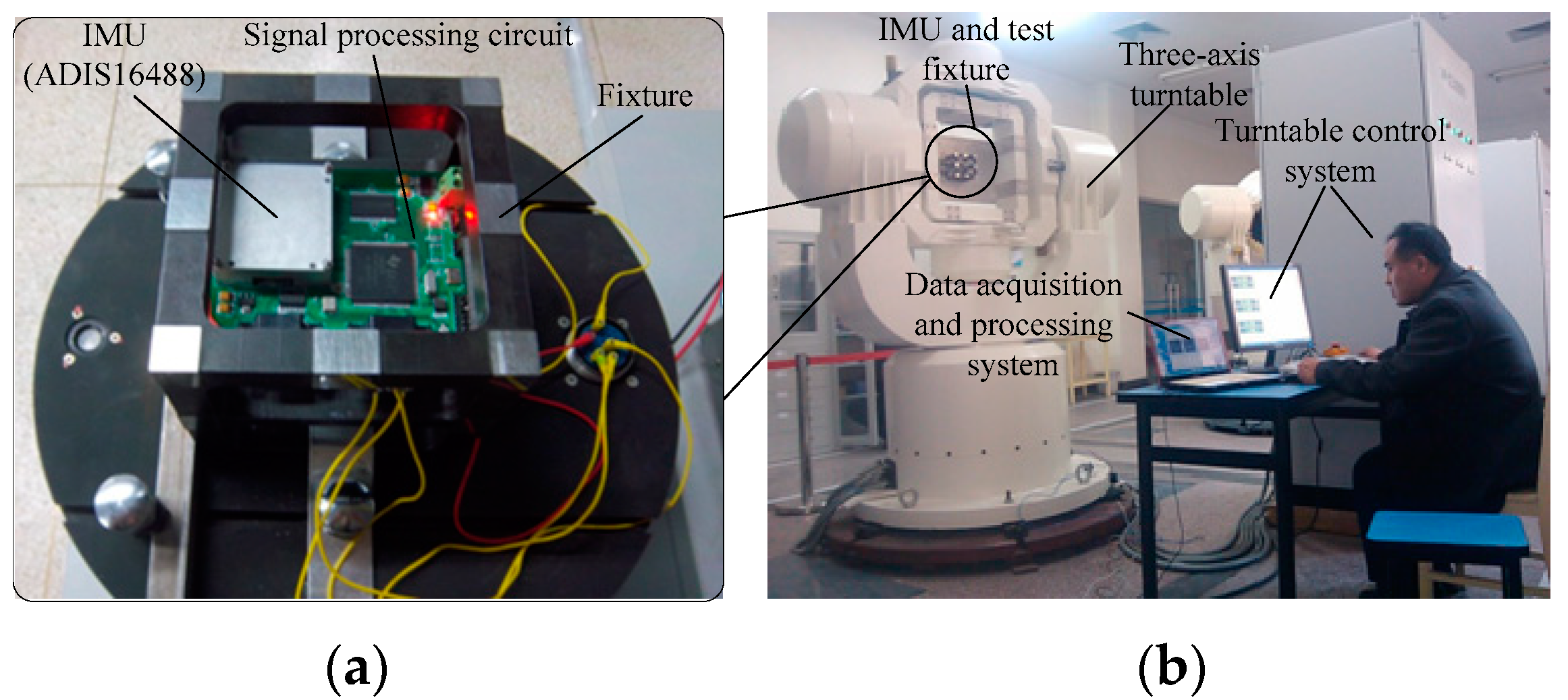
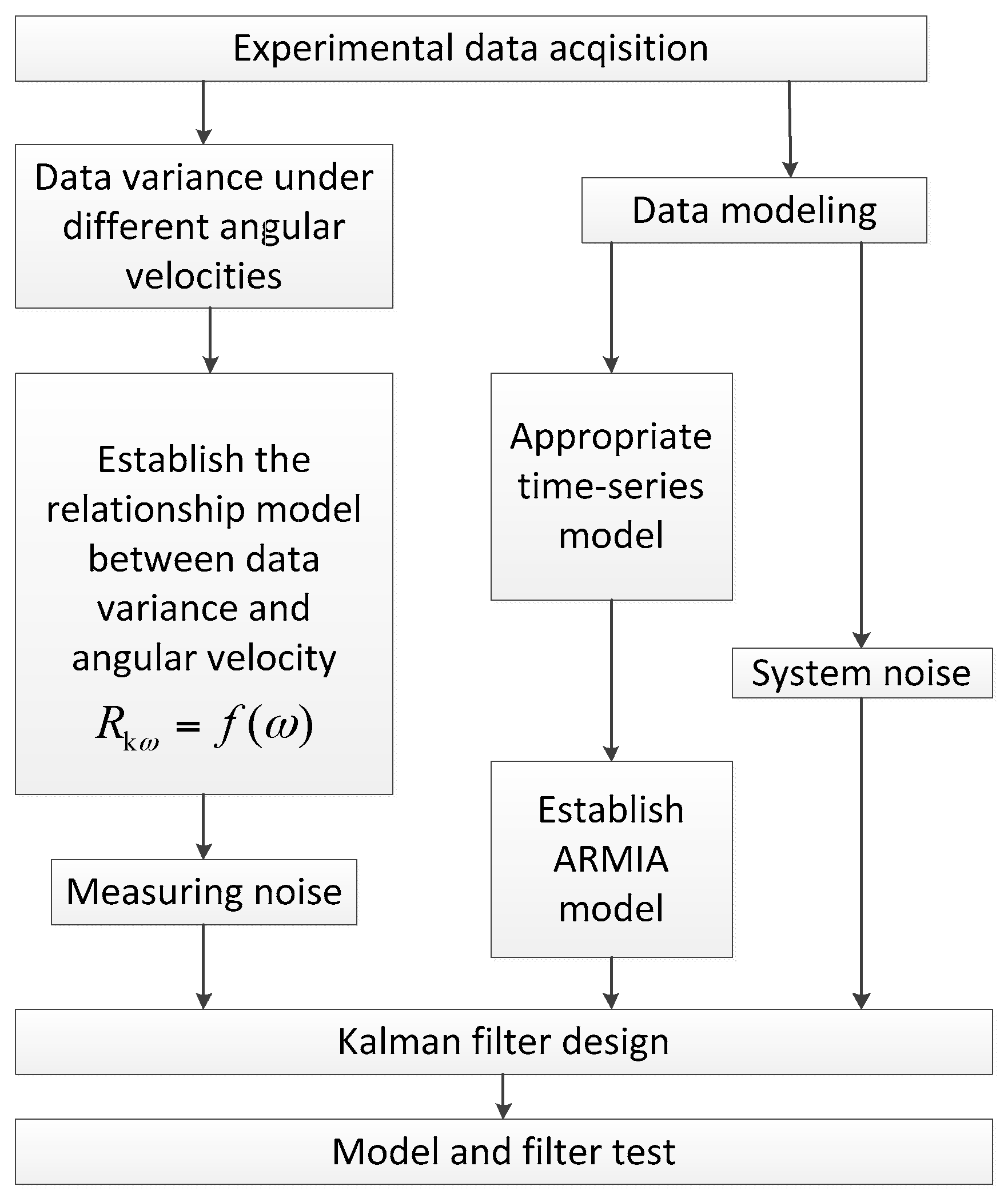
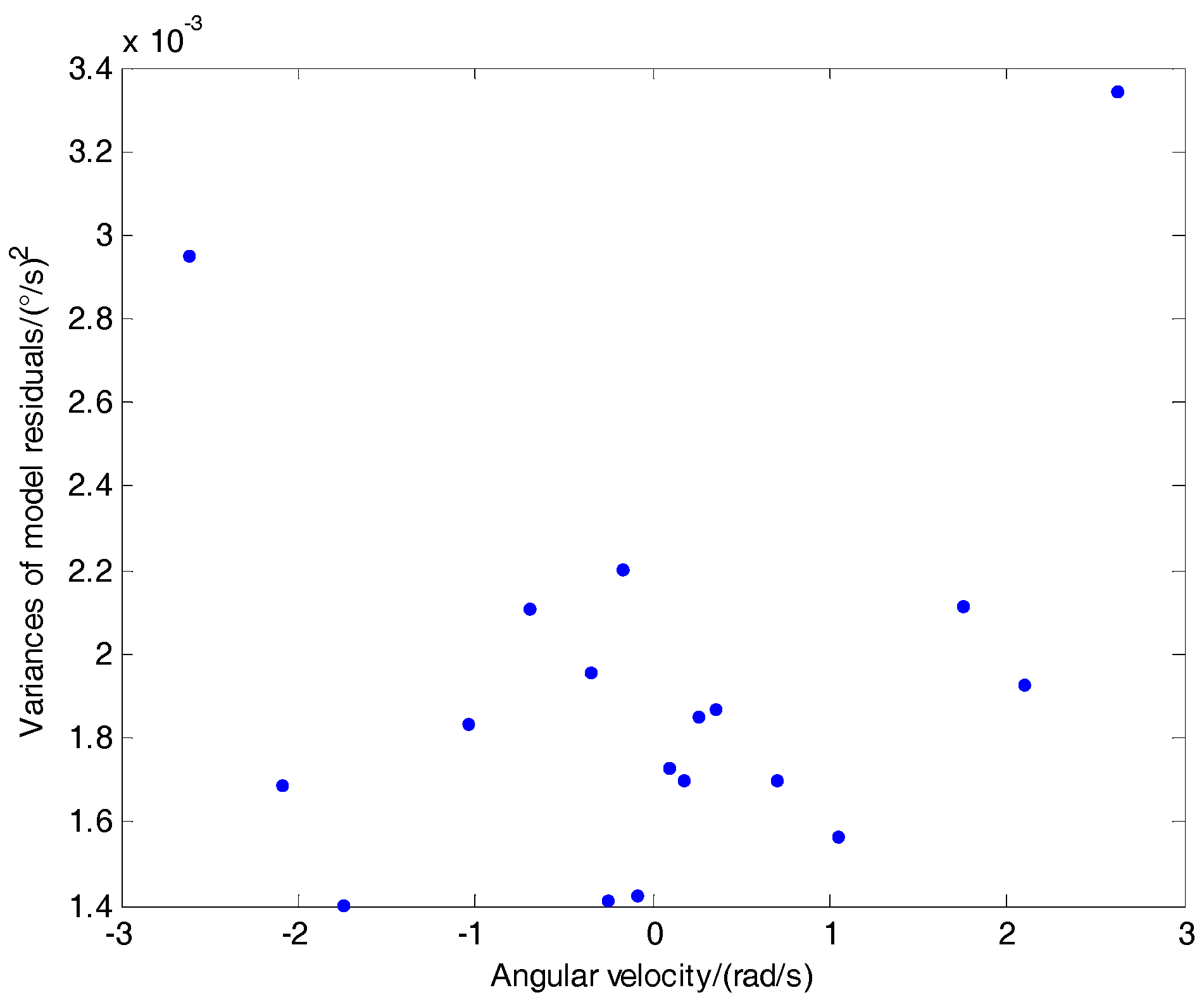


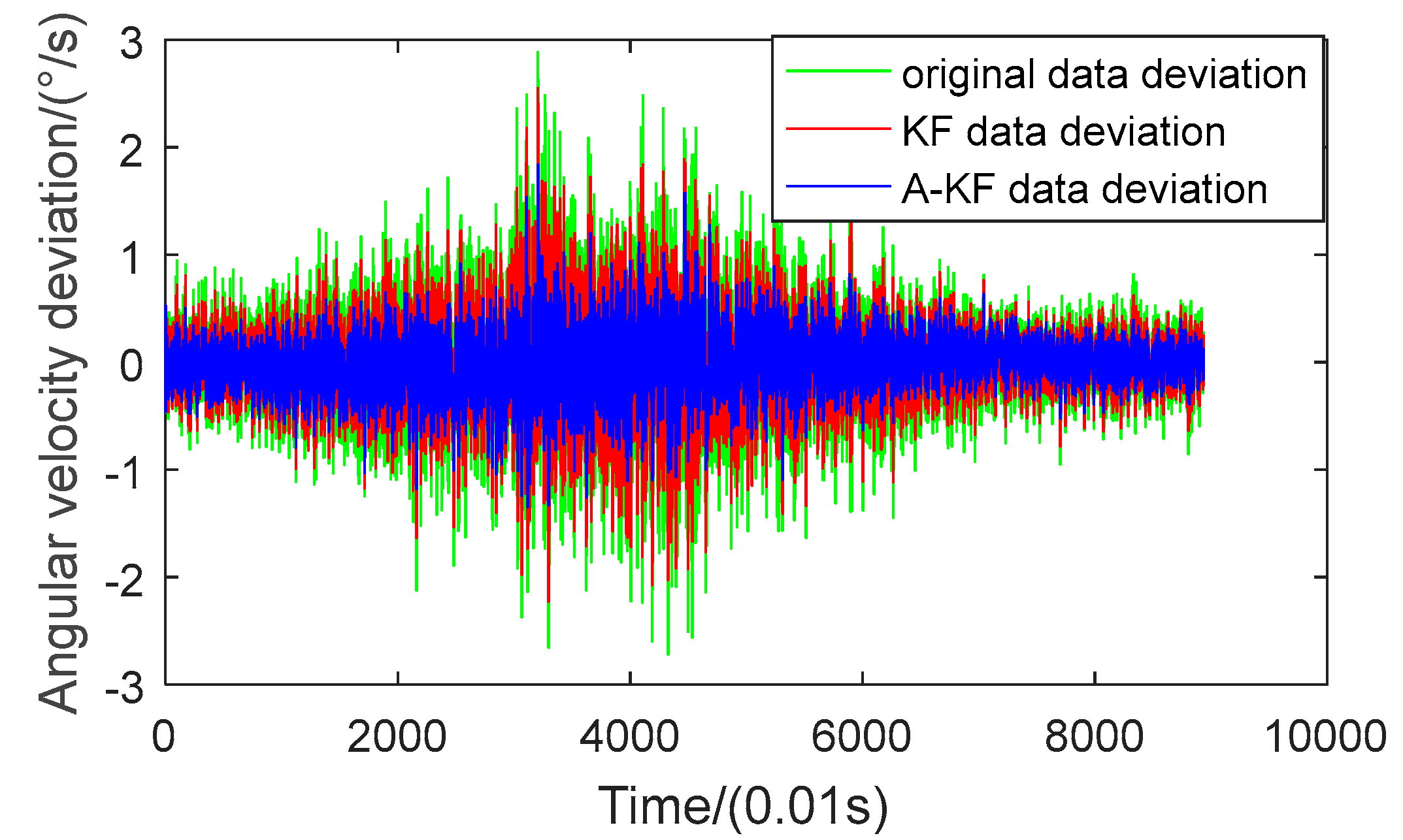

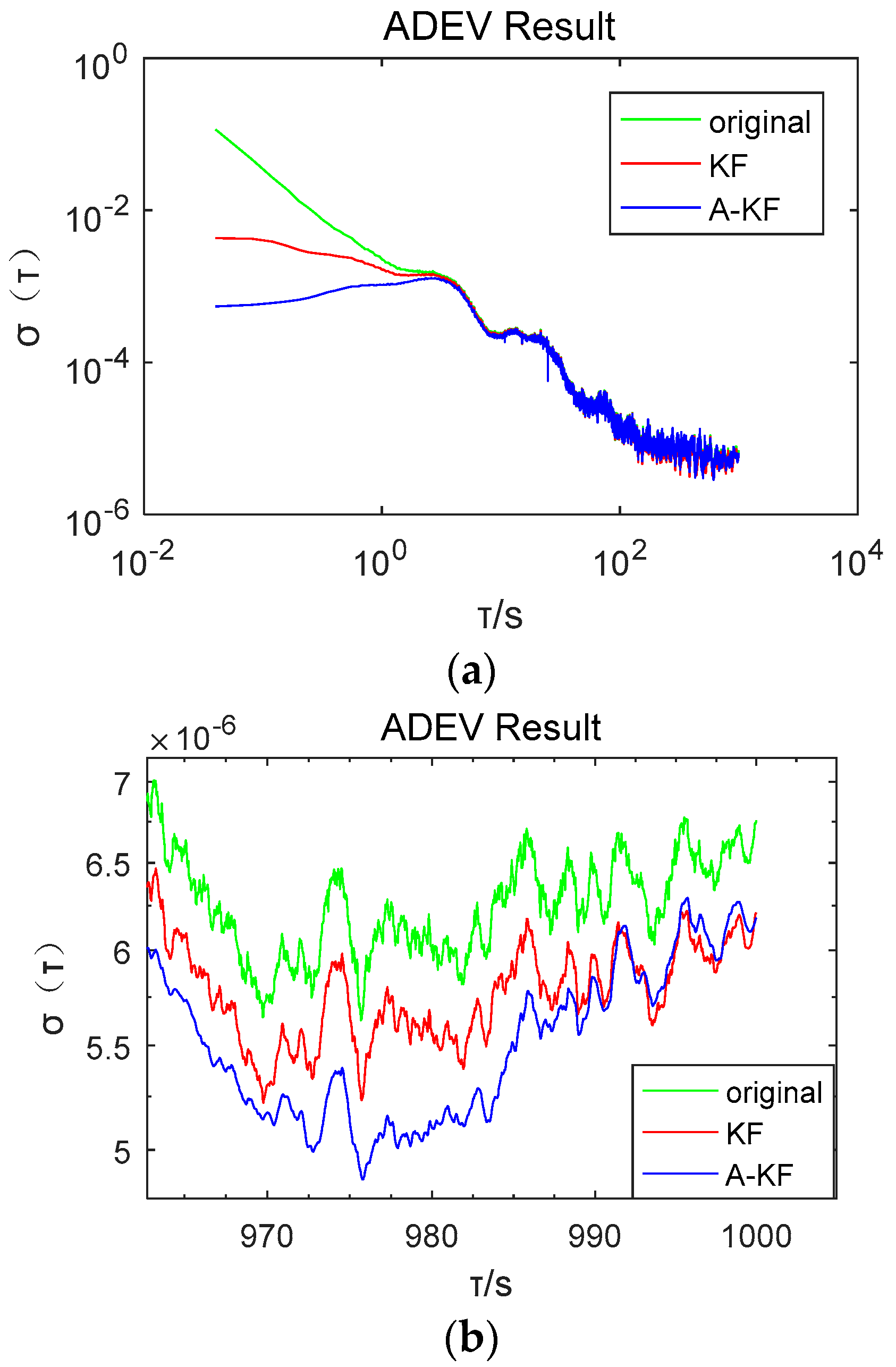
| (°/s) | Data Variance | (°/s) | Data Variance |
|---|---|---|---|
| −5 | 0.0264 | 5 | 0.0269 |
| −10 | 0.0275 | 10 | 0.0262 |
| −15 | 0.0261 | 15 | 0.0272 |
| −20 | 0.0264 | 20 | 0.0256 |
| −40 | 0.0278 | 40 | 0.0267 |
| −60 | 0.0283 | 60 | 0.0296 |
| −100 | 0.0314 | 100 | 0.0310 |
| −120 | 0.0359 | 120 | 0.0332 |
| −150 | 0.0456 | 150 | 0.0458 |
| Angular Velocity (°/s) | 40 | |
| Variance of original data | 0.0267 | |
| KF | Variance after filtering | 0.0084 |
| Percentage | 31.5% | |
| A-KF | Variance after filtering | 0.0040 |
| Percentage | 15% | |
© 2018 by the authors. Licensee MDPI, Basel, Switzerland. This article is an open access article distributed under the terms and conditions of the Creative Commons Attribution (CC BY) license (http://creativecommons.org/licenses/by/4.0/).
Share and Cite
Zhang, Y.; Peng, C.; Mou, D.; Li, M.; Quan, W. An Adaptive Filtering Approach Based on the Dynamic Variance Model for Reducing MEMS Gyroscope Random Error. Sensors 2018, 18, 3943. https://doi.org/10.3390/s18113943
Zhang Y, Peng C, Mou D, Li M, Quan W. An Adaptive Filtering Approach Based on the Dynamic Variance Model for Reducing MEMS Gyroscope Random Error. Sensors. 2018; 18(11):3943. https://doi.org/10.3390/s18113943
Chicago/Turabian StyleZhang, Yanshun, Chuang Peng, Dong Mou, Ming Li, and Wei Quan. 2018. "An Adaptive Filtering Approach Based on the Dynamic Variance Model for Reducing MEMS Gyroscope Random Error" Sensors 18, no. 11: 3943. https://doi.org/10.3390/s18113943
APA StyleZhang, Y., Peng, C., Mou, D., Li, M., & Quan, W. (2018). An Adaptive Filtering Approach Based on the Dynamic Variance Model for Reducing MEMS Gyroscope Random Error. Sensors, 18(11), 3943. https://doi.org/10.3390/s18113943





